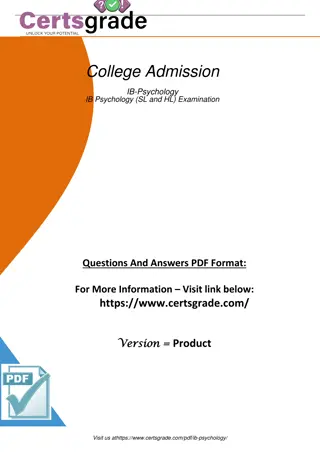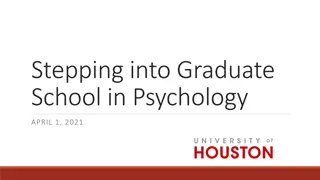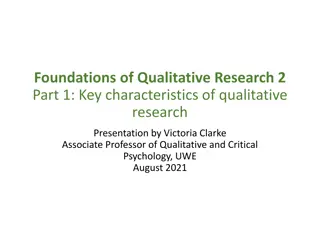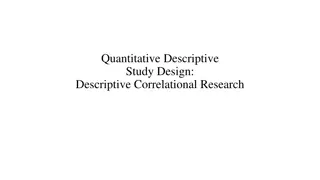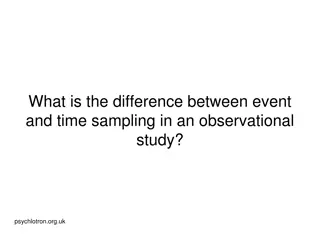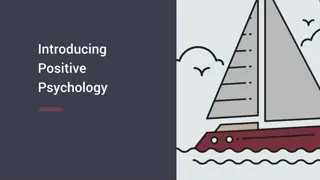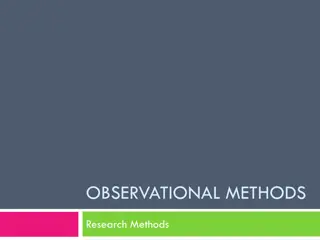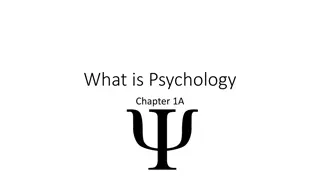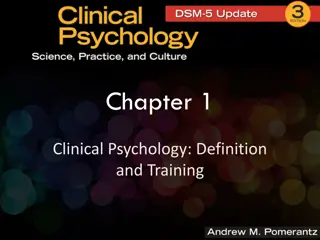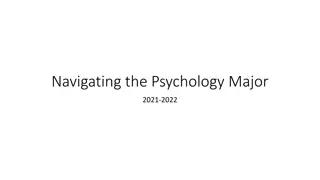Understanding Correlational Research in Psychology
Correlational research in psychology focuses on determining the degree of relationship between variables without manipulation. It helps show the magnitude of association but not causation. Correlation coefficient indicates the existence, degree, and direction of the relationship between variables. Positive correlation implies high scores in one variable associated with high scores in another, while negative correlation suggests high scores in one variable linked with low scores in another. The purpose of correlational research includes explaining important human behaviors and predicting possible outcomes based on predictor and criterion variables.
Download Presentation

Please find below an Image/Link to download the presentation.
The content on the website is provided AS IS for your information and personal use only. It may not be sold, licensed, or shared on other websites without obtaining consent from the author. Download presentation by click this link. If you encounter any issues during the download, it is possible that the publisher has removed the file from their server.
E N D
Presentation Transcript
CORRELATIONAL RESEARCH
CONCEPT OF CORRELATIONAL RESEARCH Correlational research is designed to determine the degree of relationship between 2 or more variables. Also referred as Descriptive Research or Associational Research . Often naturally occurring variables are: Intelligence and GPA Aggression and watching TV Shows Alcohol consumption and driving ability
NATURE OF CORRELATIONAL RESEARCH Relationships among two or more variables are studied without any attempt to influence them. There is no manipulation of variables in Correlational Research. With correlational research, we can only show the magnitude or degree of relationship or association between variables, NOT the CAUSE OF RELATIONSHIP.
CONT: Correlational studies can suggest that there is a relationship between two variables, they cannot prove that one variable causes a change in another variable. In other words, correlation does not equal causation. For example, a correlational study might suggest that there is a relationship between academic success and self-esteem, but it cannot show if academic success increases or decreases self- esteem. Other variables might play a role, including social relationships, cognitive abilities, personality, socio-economic status, and a myriad of other factors.
CORRELATION COEFFICIENT Correlational studies describe the variable relationship via a correlation coefficient. A correlation coefficient identifies Existence Degree [ -1.00 to 0 to +1.00] Direction Sign (+ or -) gives direction of relation The correlation coefficient, denoted by r.
CORRELATION COEFFICIENT Positive Correlationmeans that high scores in one variable (X) are associated with high scores in another variable (Y) and vise versa. A correlation coefficient close to +1.00 indicates a strong positive correlation. E.g. High attendance ratio can predict high grades. Negative Correlation means that high scores in one variable (X) are associated with low scores in another variable (Y) and vise versa. A correlation coefficient close to -1.00 indicates a strong negative correlation. E.g. As the amount of addiction toward TV shows increases, the GPA decreases. No Correlation means that change of score in one variable (X) do not effect scores of another variable (Y). correlation coefficient of 0 indicates no correlation.
PURPOSES OF CORRELATIONAL RESEARCH Explaining Important Human Behaviors. Prediction of a PossibleOutcome. o o e.g. High school grades can be used to predict college grades. Predictor Variable is that which is employed to make a prediction. e.g. High school grades. Criterion Variable is the variable about which the prediction is made. e.g. College grades.
TYPES OF CORRELATIONAL RESEARCH Observational/Naturalistic research Type of correlational (i.e., non experimental) research in which a researcher observes ongoing behavior e.g. class attendance and grades Survey research Here researcher selects a sample of respondents from a population and administers a standardized questionnaire to them. e.g. living together and divorce rates Archival research From data already available through e.g. violence and economics
ADVANTAGES OF NATURALISTIC OBSERVATION Gives the experimenter the opportunity to view the variable of interest in a natural setting. Can offer ideas for further research. May be the only option if lab experimentation is not possible.
DISADVANTAGES OF NATURALISTIC OBSERVATION Can be time consuming and expensive. Does not allow for scientific control of variables. Experimenters cannot control extraneous variables. Subjects may be aware of the observer and may act differently as a result.
ADVANTAGES OF THE SURVEY METHOD It s fast, cheap, and easy. Researchers can collect large amount of data in a relatively short amount of time. More flexible than some other methods.
DISADVANTAGES OF THE SURVEY METHOD Can be affected by an unrepresentative sample or poor survey questions. Participants can affect the outcome. Some participants try to please the researcher, lie to make themselves look better, or have mistaken memories.
ADVANTAGES OF ARCHIVAL RESEARCH The experimenter cannot introduce changes in participant behavior. Enormous amounts of data provide a better view of trends, relationships, and outcomes. Often less expensive than other study methods. Researchers can often access data through free archives or records databases.
DISADVANTAGES OF ARCHIVAL RESEARCH The researchers have not control over how data was collected. Important date may be missing from the records. Previous research may be unreliable.
THREATS TO INTERNAL VALIDITY IN CORRELATIONAL RESEARCH
CONT: INSTRUMENT DECAY Using particular instrument many times, there is possibility of instrument decay. Care must be taken to ensure observers don t become tired, bored or inattentive
CONT: DATA COLLECTOR BIAS Unconscious bias on the part of data gatherers when both instruments are scored by same person. For example high score in first test may lead to examiner expectation of high score in second test. Solution is to have different administrators for each test.
CONT: DATA COLLECTOR CHARACTERISTICS Threat is there if different persons administer both instruments. For example gender or age may effect specific responses, particularly in attitudinal instruments. Can be avoided by having each instrument administered by different individual.
CONT: TESTING Responding to first instrument may influence subject responses to second instrument. Solution is to administer instruments at different times and contexts. MORTALITY It is not a problem of internal validity. Loss of subject may create threat to external validity.
Basic steps in Correlational Research
PROBLEM SELECTION The description of problem in hand, which need to be analyzed. The problem have to be selected, defined and delimited. Is variable X related to Y? How well does variable X predict variable Y? What relationships exist among a number of variables and what predictions can be made based in them?
SAMPLE SELECTION Use random sampling techniques. Sample size is at least 50 (Gay, 2003). Samples larger than 50 are much more likely to provide meaningful results. (Fraenkel & Wallen, 2005). It is important to select valid, reliable measures of variables. If the data is inadequate it will result in inaccurate correlational coefficient (Gay,2003).
INSTRUMENTATION & VALIDATION Data sometimes can be collected from records of one sort or another(grade transcripts, for example), most correlational studies involve the administration of some type of instrument (tests, questionnaires, and so on) and sometimes observation. Instruments to be used has to be valid, reliable and should yield quantitative data.
DESIGN AND PROCEDURE Two or more scores are obtained for each member of the sample, one score for each variable of interest, and the paired scores are then correlated. The result is expressed as a correlation coefficient.
DESIGN AND PROCEDURES Basic design used in correlational research is straight forward. Observations Respondents A ________ ________ O1 O2 B ________ ________ C ________ ________ D ________ ________ E ________ ________
DATA COLLECTION Collect the data for each of the variables to be studied with the use of the instruments the researcher has prepared/ selected.
DATA ANALYSIS TECHNIQUES Correlation of two variables results in correlation coefficient. Correlation coefficient is a decimal number between 0 and -1 and between 0 and +1. Typically the Pearson s Product Moment CorrelationCoefficient or the Pearson s r Correlation Coefficient is used for correlation analyses.
CONTINUED Pearson correlation This technique is best for linear relationships. example is height and weight of growing children. They are related follow a straight line. 6 5 4 3 Height 2 1 0 Weight 0 2 4 6
CORRELATION COEFFICIENT -1.00 0.00 +1.00 strong positive strong negative no relationship
PLANNING THE ANALYSIS OF DATA The scale for describing the magnitude of correlation has to be specified. Correlation Coefficient Relationship .00 - .20 Negligible .20 - .40 Low .40 - .60 Moderate .60 - .80 Substantial .80 1.00 High to Very High (Guiford & Fruchter, 1981)
STANDARD ERROR OF ESTIMATE (SE) Predictor and criterion don t usually have a perfect correlation. So, an attempt to use X to predict Y is likely to result in a certain degree of error. Y predicted vs. true/actual Y (difference in this is known as error score). The standard deviation of the error scores across all individuals is known as SE. Note: the smaller the SE, the more accurate the prediction!
NO CORRELATION y x
NO CORRELATION y x
REPORTING THE RESULTS AND CONCLUSIONS OF THE STUDY Findings for each problem posed in the study are summarized statistically and conclusions are drawn. Recommendations are formulated by the researcher based on the significant findings noted.
REFERENCES Cherry, K. (n.d.) Correlational studies: Psychology correlational studies. Retrieved from http://psychology.about.com/od/research methods/a/correlational.html. research with Fraenkel, R., & Wallen, E.(2005). How to Design and Evaluate Research in Education (6th ed.). San Fransisco: Corwin. Gay, L.R.(2003). Educational research (5th ed.). Florida International University. Florida: Muller, A. (2002). Education, income inequality, and mortality: A multiple regressions. Retrieved 10th july, 2001, from http://www.bmj.com/content/324/7328/23. The survey system. Retrieved from http://www.surveysystem.com/correlation.htm

 undefined
undefined







